Tel.: +7(495) 935-81-86 | Е-mail: ale@aqualogo.ru
EXPOSITION OF THE VORONEZH OCEANIARIUM IN CITY PARK "GRAD"

Developing the concept of oceanarium in the RIO mall in Moscow and in the Grad mall in Voronezh, Aqua Logo Engineering specialists decided not to limit the species of animals to hydrobionts only, as it is common in most public aquariums. In our opinion, aviaries and terrariums with terrestrial mammals, birds and reptiles diversify the exposition and clearer show visitors natural biotopes where the inhabitants of land and water coexist in different parts of the world.
Someone may consider zoo in the oceanarium to be superfluous, someone can get even annoyed by it, but not children. Our exploitation experience from Moscow and Voronezh oceanariums shows that children are excited not only by fishes and seals. With great pleasure they try to communicate with monkeys and meerkats, interestedly view raccoons, coatis and flying foxes. The oceanarium is not only entertaining, but also educational leisure place for all visitors, especially for children. Our oceanariums provide for scientific and educational activities. Voronezh oceanarium has separate lection room for this aim.
Both oceanariums, in Voronezh and in Moscow, are united by idea of zoning expositions over climatically similar animal habitats. The exposition of Voronezh oceanarium divides to four thematic zones, two of them contain not only aquariums and aquaterrariums, but moreover aviaries for terrestrial animals. These are zones “Forests and steppe” and “Jungle”. Let’s take a walk over the oceanarium.
Scheme of the Voronezh Oceanarium
Exposition "Forests and steppes"
In front of entrance to first zone “Forests and steppes” there is a cylindrical aquarium (diameter of 2 meters) with knifefishes. This zone introduces visitors to the diversity of freshwater fish in the central part of Russia, as well as to the inhabitants of Russian, African and American forests and steppes. There are further objects in the zone: aviary-aquarium “The River Otters”, aviary with raccoons, African aviaries with servals and meerkats, aviaries with hystrix, squirrels, coatis and mongooses. Visitors and especially children literally cannot tear away from these aviaries.





There is also giant aquarium with nymphaeas (water lilies) and great cascade of large open freshwater aquariums “The fishes of Russia”. In the unique fish collection, which was enthusiastically collected by curator of Voronezh oceanarium V.I.Butsay, there are almost 20 species of sturgeon, large European catfishes, grass and common carps and so on. Dry diorama over this aquarium complex with huge sturgeons and carps realistically recreates a fishing steading with a porch right by the river, a water mill wheel and fishing nets.



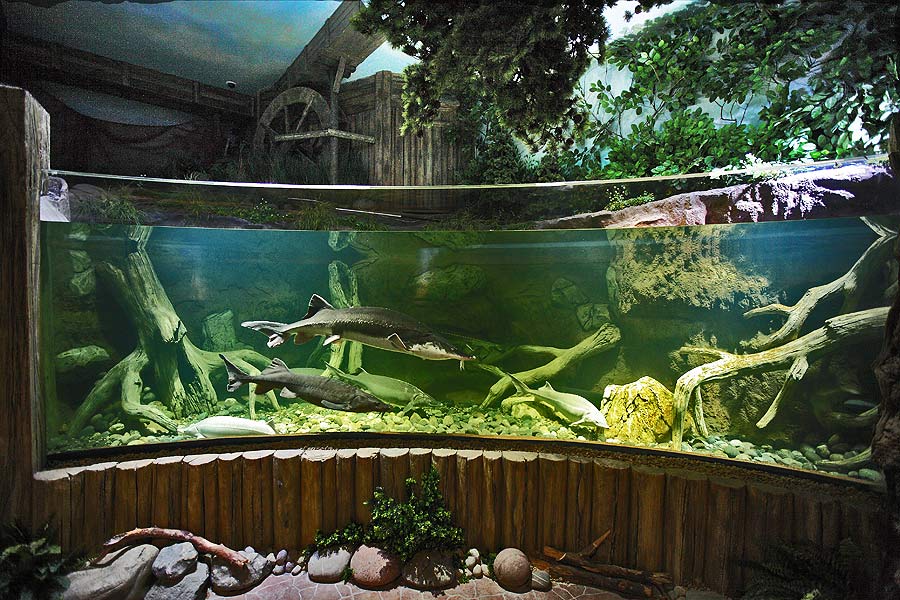

Exposition "Polar Waters"
In the second thematic zone “Polar waters” the harsh nature of the northern seas is recreated. A spacious aviary of north fur seals with living compartment and seal shows compartment meets guests at the very beginning, the tribunes for visitors stand opposite to it. Near it there is a huge aviary for penguins. We await arrival of Humboldt penguins or South African black-footed penguins. At the zone with aviaries for seals, penguins and monkeys we constructed windows in the walls for natural insolation, such necessary for animals. The big aquarium with wave machine is decorated with painting on the wall – Far Eastern landscape with the mountain river and decorations with a steaming Kamchatka geyser and a creek breaking from a rock. The great amount of trout lives in the aquarium, especially unique golden trout.





In the “Polar waters” zone the annular aquarium, unique for Russia and the CIS, dominates visually, being located at the podium in the form of frozen rock formations. Usually in the annular or cylindrical aquariums sea gregarious fish seems spectacular. However, seasonality of the capture, big waste, difficulty of delivery and maintenance herring fishes cost pretty expensive. Only few oceanariums can afford to exhibit such aquariums in their whole splendor. In the Voronezh oceanarium we managed to realize the concept of spectacular annular movement of gregarious fish, not yielding to world leaders in visual effect, but using relatively modest means. The usual young peled from the ordinary Nizhny Novgorod fish farm has been put into the cold-water annular aquarium.





Silver pelad perfectly harmonize with light “polar” interior decoration. At the same time pelad moves in the aquarium not chaotically, but moves around in the circle by a flock. Such coordinated pelad movement is regulated by creation of annular water flow and natural reoreaction of pelagic fishes. Especially spectacular the aquarium with the flow of fish looks from the inside. We hope our experience will be useful for other oceanariums. Though, these aren’t all surprises of “Polar waters” zone. King crabs settle in one of the two last sea aquariums, in another – the pride of the oceanarium, 9-kilogramms giant Pacific octopus from Japan. The “Polar waters” zone will replenish with new 20-cubes aquarium “Japanese sea” soon.
Exposition "Jungle"
The tropical zone “Jungles” begins with the aviary where we surprisingly managed to combine deserted fennec foxes with lemurs. These pretty animals perfectly live together and are especially loved by children. Then there is a bunch of aquaterrariums unique by beauty and species composition. The pride of the collection is an alligator snapping turtle that lives in the water space of the aviary and a huge and very beautiful iguana that lives in the terrestrial space. In the next aviary, equipped with water and terrestrial zones, a giant anaconda, a python and a monitor lizard live.



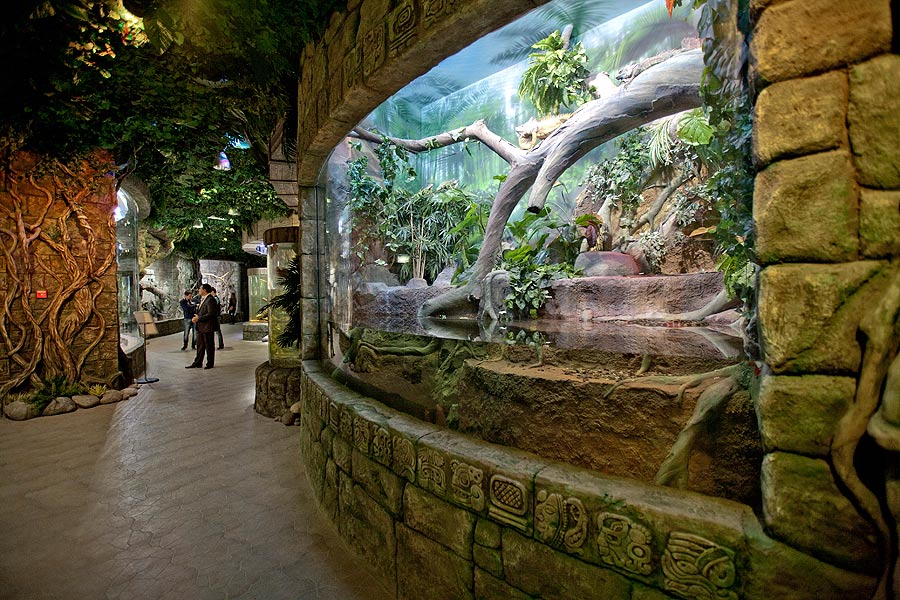

Further on the route the visitors can see a giant baobab, around which there are a number of large open tropical aquariums. At the same place two cylindrical aquariums connect the arc open aquariums into one, like the watchtowers of the fortress wall. A similar exposition of the Dubai oceanarium inspired such a decision of the customer. Our engineers had to hardly work to glue together surfaces, different in geometrical form, closely without gaps and using of silicone with the glue “Acrifix”. Here, in these aquariums, famous zoologist V. Butsay collected a unique collection of freshwater tropical fishes. Here is an aquarium with piranhas, at the bottom of which the waxwork of picked cow skeleton, aquariums with big knifefishes, catfishes, electric eels, large bala sharks and even American paddlefishes. All these aquariums locate around the giant banyan, decorated in jungles theme, and look magnificently.




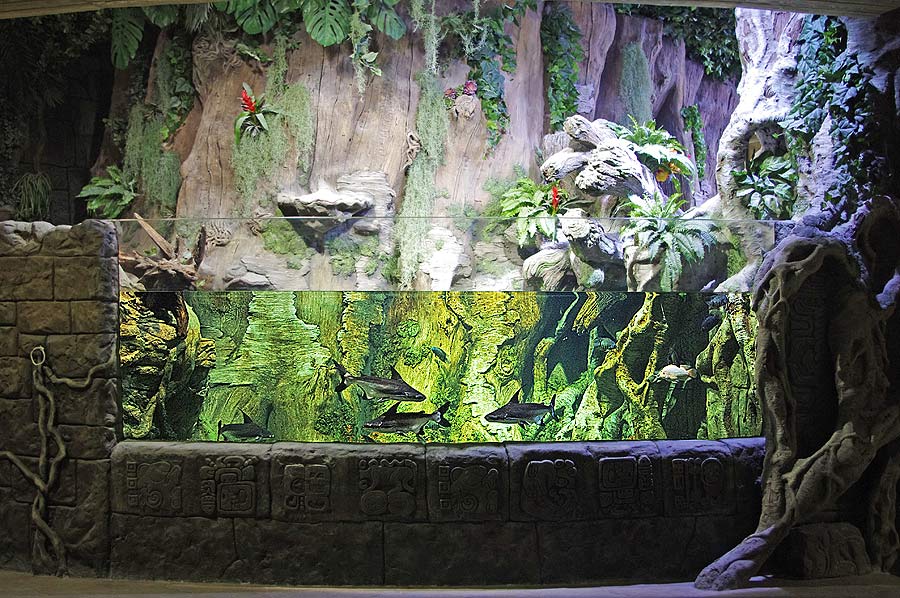
Opposite to this aquarium complex there are dry aviaries. The first spacious aviary gives home for arboreal monkey mangabeys, the second one – for long-tailed macaques. Then, there is an aviary with white-nose marmosets, very beautiful aquaterrarium with spectacled caimans and an aviary with tropical parrots, blue-and-gold macaws and cockatoos.





The “Jungles” zone ends with the unique open aquarium with large arapaimas (more than 1 meter length), big catfishes and paku. The original decoration of the exposition includes a wing and other parts of the fallen airplane of Indiana Jones. At the lateral sides of the aquarium, in the insectariums, decorated as hollows, real poisonous spiders friendly meet visitors. Next, there are small aquariums with selective discus, a terrarium with turtle mata-mata, aquariums with live mangroves, mudskippers and characin fishes.
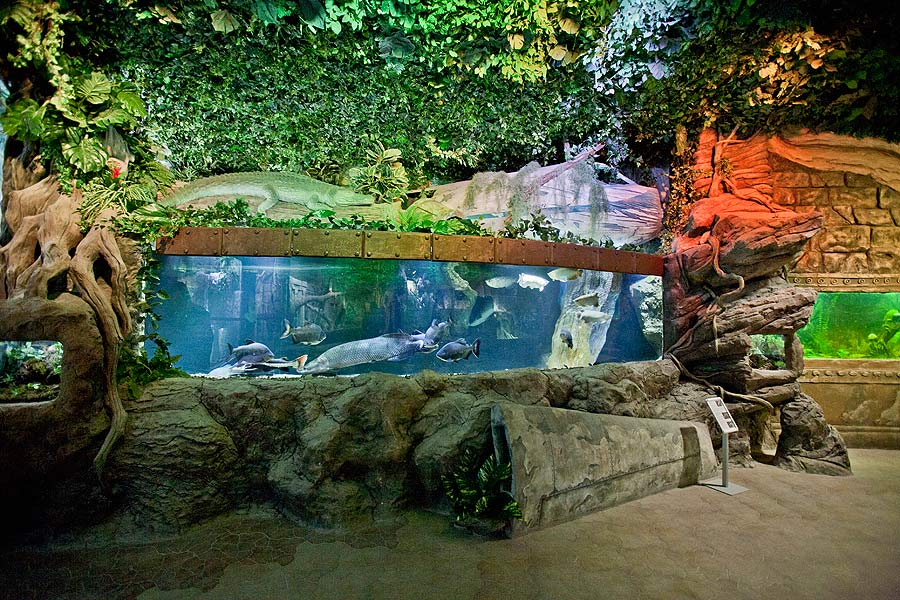
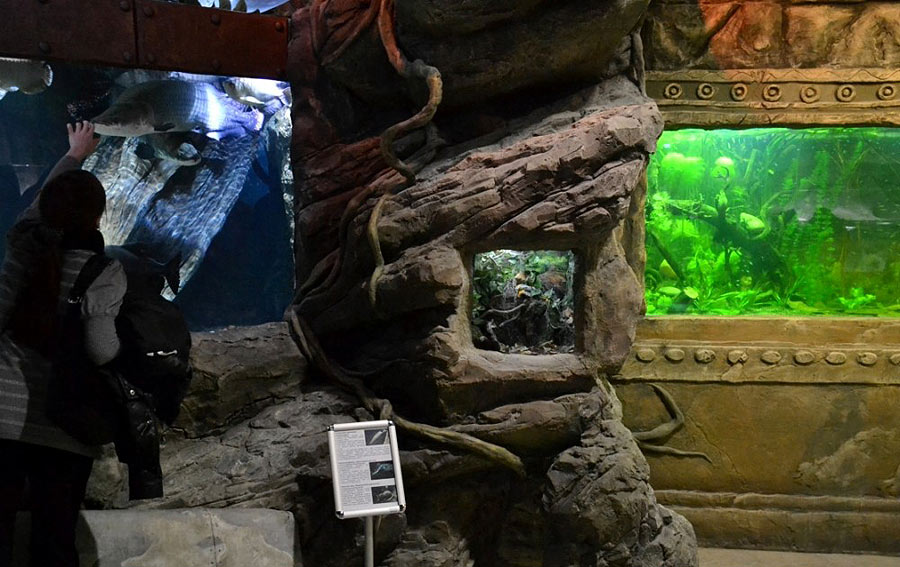


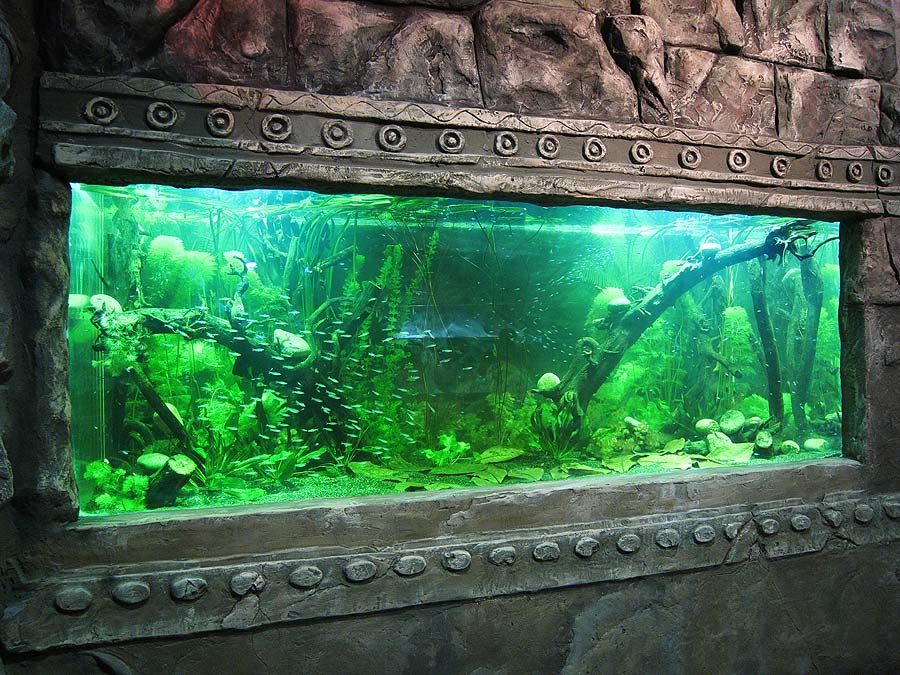
Exposition "Seas and Oceans"
The biggest sea aquarium with a capacity of 370 m2, with sight glasses and two acrylic tunnels, opens the fourth exposition “Seas and oceans”, where are collected about 40 species of the most impressive representative species of tropical ocean fish: sharks, stingrays, barracudas, muraenas, marine angelfishes, surgeonfishes, epinephelus and triggerfishes. The decorations are made in the form of a sunken ship, entwined with tentacles of a giant octopus. Through the large window of the main aquarium and sitting on the tiered benches, it is easy for visitors to observe the feeding of sharks, which is carried by drivers at the certain time especially for the public.






At the exit of the main tank in the hall of seas and oceans there are two big open sea aquariums with dry tropic decoration. One of them contains bottom sharks and stingrays, the other contains butterflyfishes, other tropical fishes and live corals. Also, there is a cylindrical aquarium with lionfishes in the center of the hall and three relatively small aquariums with sea hydrobionts near the wall.


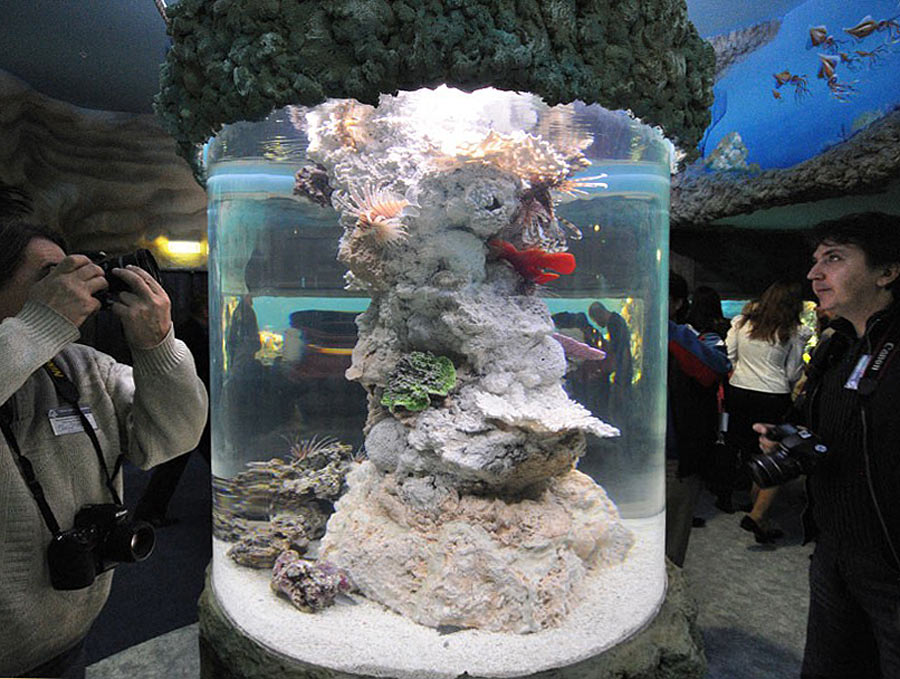
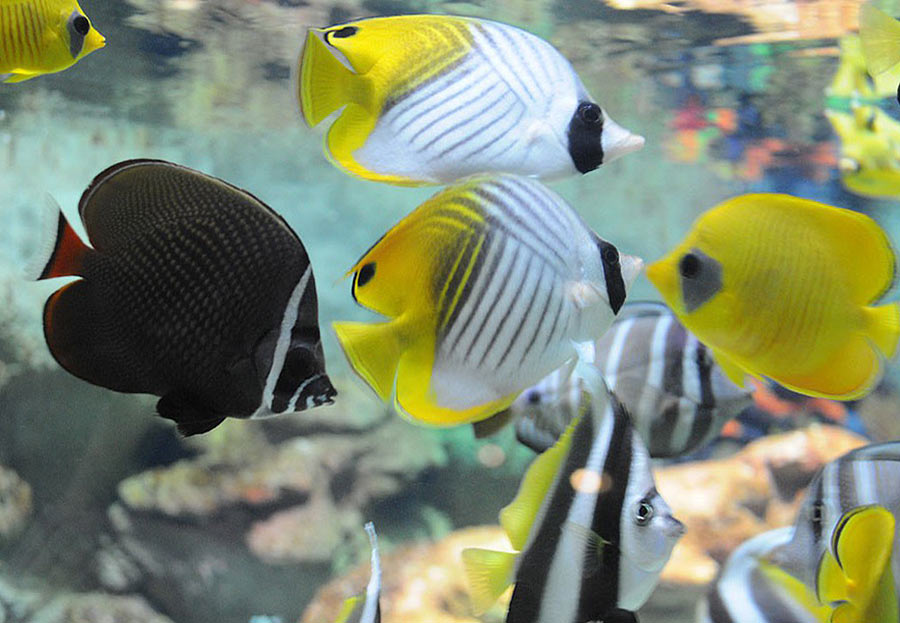

Especially popular among visitors of the Oceanarium are aviaries and aquariums with animals such as meerkats, mangabeys and sharks. Near these exposures there is a constant accumulation of people and it is here where enthusiastic exclamations and laughter are heard. It gives us possibility to assume that an oceanarium, showing only habitats of water environment, is less interesting than an oceanarium-exotarium which gives us a chance to see and become acquainted with different animals lived at our Earth. Anyway, the queue to the Voronezh Oceanarium is more eloquent than any words.






